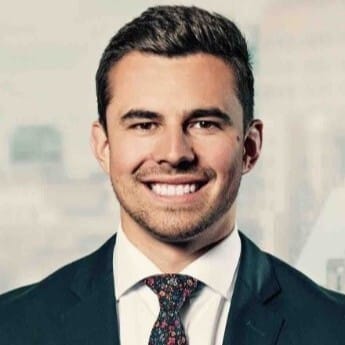When it comes to tackling the increasingly complex problems of 21st-century banking like sanctions, AML, and KYC, who better to partner with than someone who’s been in your shoes? Before our Head of Financial Crimes Strategy, Grant Vickers, joined WorkFusion, he spent nearly a decade at Ernst & Young and the U.S. Treasury — dealing with the very same pain points as our customers.
We sat down with Grant to talk about his former roles, how he leverages his industry intel today at WorkFusion, and his mission to solve the toughest problems in banking not only for our customers, but the industry at large. This interview has been edited for length and clarity.

WorkFusion: So Grant, in a nutshell, what do you do at WorkFusion?
Grant Vickers: I’m essentially WorkFusion’s industry SME when it comes to financial crimes and sanctions compliance. That plays out in a few ways. First, I advise our product team on the product strategy. So, understanding what’s going on in banking compliance, the types of machine learning, and the areas where digital worker automations can most impact the industry, and then advising our product team on how to build those things — across the AML, KYC, and sanctions space.
The second thing I do is to pair up with a customer or prospect and ensure that our products are meeting their operational goals and KPIs, as well as regulatory and examination expectations. So, a lot of our customers will say, “Hey, Grant, can we rely on you helping us understand these types of models? And will these models pass our own MRM [model risk management] committees? How do examiners think about these things in the sanctions space where there’s strict liability and a lot of scrutiny?” And I’ll help walk our customers through: “Hey, from my past experience working at Treasury or advising banks as a consultant, here’s the things to consider. Here are the types of programmatic changes you might want to make. And here’s where the best places are for this technology to be deployed.”
So, I have both an internal advising and a customer-facing role here at WorkFusion.
WF: Can you tell us a little bit about your past experience in AML and sanctions compliance for other financial institutions?
GV: Yeah, absolutely. I spent about the first 10 years of my career at Ernst & Young in their Financial Crimes Compliance group. I did a number of different consulting engagements for large global and international institutions. That’s everything from independent AML risk assessments, to sanctions reviews and remediations, to transaction monitoring lookbacks. We did a lot of program reviews. Essentially, we were advisors to the BSA, AML, OFAC compliance officer in many instances.
From Ernst & Young, I went to the U.S. Department of Treasury, where I was a sanctions policy advisor for the Middle East and Asia desks. So as a part of that job, we worked across the U.S. and the global financial communities to help ensure the integrity of the global financial system.
And then from Treasury, I came to WorkFusion.
WF: What motivated you to join WorkFusion? Did your past experience in compliance and operations lead you to WorkFusion in any direct sense?
GV: Yeah. My whole career has been based around helping build the integrity of the financial system, right? So, whether that was in a consultative role, or working for the U.S. government, or here at WorkFusion — every position I’ve held has built toward that goal. What made me very interested in WorkFusion was getting into the technology side.
FATF (the Financial Action Task Force) has recently put out a number of publications on using innovative tools to fight financial crime and the proliferation of weapons of mass destruction…, essentially using innovative tools to strengthen the global financial system — and that’s what WorkFusion does.
We have built products that are specifically focused on the AML, KYC, sanctions space at banks. And we’re providing some really innovative products to help these institutions comply with regulations, fight crime, and to make this work more efficiently as they do it. That’s what piqued my interest in WorkFusion. That’s why I’ve really enjoyed my time here, why I’m loving continuing to build out our products in this space.
WF: How are you helping to solve the problems that you used to face in your former role, now at WorkFusion?
GV: You know, if you look over the last 20–30 years in this space within the banking industry, there hasn’t been a ton of innovation, to be honest with you. There are problem statements today that existed 20–30 years ago, and banks have been slow in really trying to find innovative ways to solve these things.
In the last handful of years, we’ve seen technology sharply increase and banks really start to bring automation, AI, and machine learning into this space. But it is a heavily regulated space, a heavily scrutinized space. And so banks historically have been hesitant to try things that are a little bit outside the box, right?
So, you suddenly have banks, regulators and examiners, and global governing bodies like the FATF or the Wolfsberg Group that are issuing statements that essentially say, “Hey, we want to see more innovation in this space. We want to see banks taking a step out in terms of bringing in these types of technologies. And we’re going to give banks some space to try that. We’re going to conduct our examinations kind of in line with that.”
This is what excites me about being here and being in the space because there is an appetite to bring these tools into compliance shops. We’re seeing it. And we’re selling our products into not only large U.S. and global financial institutions but also middle market and small community banks as well. We’re seeing this across the board. It’s a really exciting space to be in.
WF: Can you elaborate a little bit on how you utilize your past experience in your current role. For example, does your experience factor into the design of our product, into our Digital Workers?
GV: Yeah, absolutely. I’ll give you a couple examples. I spent a number of years doing KYC, periodic review or refresh, at two of the top four U.S. financial institutions. Those banks have super complex KYC operations; analysts are spending 8 hours plus for high-risk KYC reviews. So, I’ve led those teams and advised those banks on how to streamline their process, how to collect the right amount of KYC requirements based on their risk profile, how to leverage third-party sources to bring those KYC requirements back into the customer profile and avoid unnecessary customer outreach. So, the big pain point items that every bank struggles with in KYC — upsetting their customers with too much outreach and not being able to gather enough KYC information from publicly available sources — I’ve lived it.
So at WorkFusion, when we go to develop our product, specifically our Digital Workers [Darryl and Kendrick] that do KYC operations, I advise our product team on what the things are we want to build. I’m advising on the best way for our product to actually integrate and interact with banks’ other core systems. Every bank’s got a bunch of legacy systems in this space that are typically hard to interact with, hard to integrate with, and that is a key piece of operationalizing our technology. So all that said, I know the space very well and I bring that expertise in helping develop products or even helping setting the vision for where banks can go.

“I essentially sat where [our customers] sit today. Whether it’s a sanctions screening position or KYC operations, I’ve both led and advised operational and compliance teams. So, I know exactly the type of problems they’re trying to solve, how to interface with examiners and other regulators in this space, and how to apply our product and our Digital Workforce to the problems they’re trying to solve.”

A lot of banks are trying to move to this idea of perpetual KYC (pKYC), or event-driven KYC. And essentially, you’re trying to get out of this periodic review cycle of looking at customers’ profiles and getting into an event/trigger-based KYC, where you’re only working specific risk-based triggers. That will expedite your reviews. It’ll take off this huge burden on your operational teams to be reviewing information that really, from a risk perspective, you don’t need to look at all that often. And we’re currently advising banks on how to move to this new pKYC model. So that’s another way where I’m leveraging my industry expertise to help set that new target operating model vision of what pKYC can be and how our technology can help enable that.
If we want to talk about the sanctions and screening side, as an ex-sanctions advisor at the Department of Treasury, I bring a ton of expertise to that arena. Our specific Digital Worker technology actually adjudicates sanctions alerts just like a human analyst would. So it takes a look at a sanctions alert and says, “This is a false positive for these reasons.” And it does this by applying a number of machine learning models to make a decision.
As a former Treasury official, I have a lens where I look at that technology through a regulatory perspective: Is this meeting regulatory requirements? Can a bank feel comfortable to leverage a technology in this strict liability space where there is zero appetite to make mistakes? Yes, and here’s why, and here’s how I can help get our customers or prospects comfortable with technology that makes decisions in a very scrutinized space.
And then from an operational perspective, we have built our technology to take away the operational burden of level 1 compliance analyst jobs. So you have this Digital Worker that’s making these decisions. How can we fit this technology into existing screening systems like Fircosoft or LexisNexis Bridger to actually take work off analysts’ plates — and do it in an efficient way? We don’t want analysts going to another system, because as an analyst in the sanctions screening process, you want to stay within the existing systems you’re working. So I will help advise product on how we build the right type of Digital Worker that does this, that takes off work, that doesn’t make mistakes, that can deliver on key operational KPIs for the bank, and also deliver on examiner expectations.
WF: So your past experience puts you in this unique position to really intimately and directly understand what our customers’ experiences and challenges are. Are there any stories or examples of times when you and a customer were particularly able to connect due to your shared experience?
GV: All the time. One example would be we had a customer come to us for their adverse media screening process. They used a specific tool in the industry, but they were having a hard time reducing some of the manual work that this tool generated. The tool would generate alerts, but then analysts would have to go to a number of different core systems to work those alerts, right? And this customer came to us and said, “Look, we’ve talked to a lot of other vendors in the industry, and they are technology generalists; They don’t really understand our problem from a compliance standpoint or from a technology standpoint, because our legacy systems are so complex. Integration points are so hard.”
So where we were able to connect, it was kind of both in those areas, right? I could understand exactly what they were trying to do from a compliance perspective. They wanted to apply technology that could do some very specific things. For instance, looking at adverse media articles and being able to determine if they were actually material risk to the bank. So a lot of banks will get adverse media or they’ll screen for negative news, but an article may come up that says you have a customer that committed some very low-dollar-amount environmental crime 10 years ago. That may be an article that the bank doesn’t care about when it comes to pulling something like that into the risk profile of the customer because they say, “Oh, it’s below a certain threshold. We don’t consider that something that would increase the risk of my customer.”
Our customer basically said it was really hard to find a vendor that could differentiate and make decisions on articles like that. That was a problem that we could solve for that customer. So that was one connecting point…
From a technological standpoint, in order for our product to work, we were going to need to integrate at a number of different integration points across their systems. But this was a problem we understood. We understood that, look, if we can’t integrate to not only your screening tool, but your case management and your customer core, and these two other legacy systems, the effect of the automation is going to be minimal until we can start to connect and work through a number of your different systems. So those are both problems that we were able to understand and work together to solve, specifically in the adverse media space.
WF: Let’s close by zooming out for a moment. What do you think is the biggest problem that WorkFusion is solving for banking today, and even looking ahead a couple years?
GV: I think hands-down right now, the biggest problem is solving for increased sanction alert volume because of the current political and geopolitical climate in the world today. The Russia-Ukraine conflict earlier this year really caused a lot of compliance challenges for banks when it came to sanctions. Banks were getting unprecedented volume spikes; We talked to a number of our prospects and customers, and their alerts volumes had doubled overnight as the U.S. Treasury Department delivered an unprecedented number of sanctions tranches.
So this is the problem where we were uniquely positioned to solve with our Digital Worker Tara connecting to sanctions screening tools and adjudicating alerts at the level 1 analyst level.
And this is the biggest problem right now because one it is one of those areas for banks that has executive-level attention because of the risk to the institution, and it is an area at banks where it is a large operational burden from an alert-review perspective. So these are things both from a risk and an operational efficiency perspective that we can solve. These are things that are important to your chief compliance officer as well as your head of operations in the first line.
Stay tuned for our next “From Finance to FinTech” Q&A featuring our Global Head of Customer Lifecycle Management, Daniel Hazel.
To learn more about our AI-enabled Digital Workers, please schedule a demo.
































